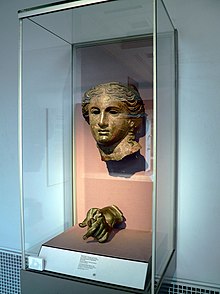| Satala Aphrodite | |
|---|---|
 The head and hand of the Satala Aphrodite on display at the British Museum | |
| Material | Bronze |
| Size | head: 35.5 cm × 31 cm × 23.6 cm (14.0 in × 12.2 in × 9.3 in)[1] |
| Created | 2nd–1st centuries BC, Asia Minor |
| Discovered | 1872 Satala (present-day Sadak, Kelkit District, Gümüşhane Province, Turkey) |
| Present location | Room 22,[2] British Museum, Department of Greek and Roman Antiquities[3] |
The Satala Aphrodite is an over-life-sized head of a bronze Hellenistic statue discovered in Satala (classical Armenia Minor,[4] present-day Sadak, Gümüşhane Province, Turkey). Probably created in the 2nd or 1st century BC in Asia Minor, it was acquired by the British Museum in 1873, a year after its discovery. It has been widely admired since its discovery and likened to the Aphrodite of Knidos by some scholars.
It is usually assigned to the Greek goddess Aphrodite, but has been associated with her Armenian equivalent Anahit, whose major temple was located not far from Satala. Consequently, head has been widely depicted in Armenian culture as a symbol of the country's pre-Christian heritage. Although not found in modern-day Armenia, there have been unsuccessful efforts to move the fragments to Armenia.
- ^ Cite error: The named reference
Nersessianwas invoked but never defined (see the help page). - ^ Gunning 2022, p. 219.
- ^ Cite error: The named reference
bmwas invoked but never defined (see the help page). - ^ Bennett, Julian (2007). "Two New Centurions of the "Legio IIII Scythica"". Latomus. 66 (2). Société d'Études Latines de Bruxelles: 405. JSTOR 41545245.
...the bronze head of Aphrodite from Satala in classical Armenia Minor, acquired by the British Museum in 1873...
